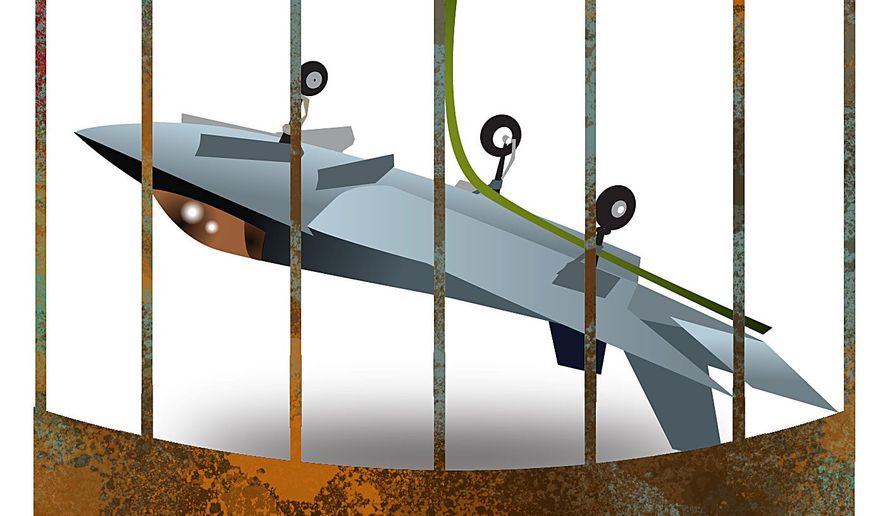OPINION:
Willfully ignoring the effects of 15 years of combat, President Obama, Congress and Pentagon leaders are causing the readiness of our combat aircraft to sink to so low a level that it clearly endangers national security. It’s a matter of shrunken budgets and awful planning.
Readiness — the ability of a force to accomplish its assigned combat mission — is measured somewhat differently among the services. But when it comes to aircraft the criteria are immutable. They’re objective measures that are based on metallurgical science and the laws of physics.
Our military went into combat a month after the Sept. 11, 2001 attacks when we attacked al Qaeda and the Taliban in Afghanistan. In the nearly 15 years since, our air forces have flown almost constantly, attacking the terrorist forces in Afghanistan, Iraq and Libya. The burden on them has worn out too many aircraft to the degree that they can no longer be flown in combat.
As reported by Fox News, only a small minority of Marine Corps aircraft — about 30 percent of the Marines’ F/A-18s — are ready to fly and only 42 of their 147 heavy-lift CH-53E helicopters are airworthy. They — like the F/A-18s — are just plain worn out.
Retired U.S. Navy Rear Adm. Mike Groothousen flew A-7 attack aircraft and F-18 strike fighters. He was captain (in combat) of the nuclear carrier USS Harry S. Truman and had four other aviation and surface commands in his career.
Adm. Groothousen told me, “In 15 years of war we’ve consumed the useful lives of many aircraft much faster than planned or budgeted for. Depending on aircraft type, that overutilization ranges from 150 percent to 300 percent beyond normal training and deployment. That’s due, in part, to additional hours flown to, from and over the target area by fewer available aircraft and increased structural fatigue caused by constantly carrying combat fuel and ordnance loads versus that of a regular day-to-day pilot training.”
As Adm. Groothousen points out, a pilot puts a lot more stress on an aircraft’s structure making a 5 g-force combat turn in an aircraft loaded with thousands of pounds of fuel and ordinance than he would flying an unarmed training mission. (Landing an aircraft with bomb and missile racks still loaded places more stress on the airframe than almost anything else. About 75 percent of our attacks against the Islamic State return with unexpended ordinance.)
When the life of a combat aircraft is used up (6,000 to 9,000 flight hours for an F-18) it has to be replaced. Before that point (at the 6,000-hour level for an F-18), it has to undergo an extensive overhaul that costs millions of dollars and can take months to perform. Part of the problem is that the necessity for these overhauls is multiplying far more rapidly than the Navy has budgeted or planned for them.
The Navy and the Air Force would both be far better off if they bought replacement F-18s, but their choices are limited because the F-35 is strangling their budgets.
Let’s focus on the Navy’s problems because they are the same as the other services’ and because we have the most comprehensive data on them — a set of PowerPoint charts used by Vice Adm. Mike Shoemaker, the Navy’s “air boss,” to brief various audiences on the state of naval aviation.
PowerPoint is one of the greatest obstacles to communication, so it takes some digging to get to useful data. One chart, labeled “Future Force Readiness,” shows that in 2016 six, out of the Navy’s 37 squadrons of F-18s have insufficient aircraft to be combat-ready. In 2020, the unready fighter squadrons will number nine out of the same 37, and that presumes that two squadrons of F-35s are declared ready for combat.
The consistently troubled F-35 is already about seven years late. Its schedule may slip more years because its enormously complex software system is still causing problems that can’t be ignored, such as switching off the radar at random moments. As Adm. Shoemaker’s briefing shows, if the F-35 schedule slips another two years, the number of unready F-18 squadrons in 2020 would be 11: nine F-18 squadrons and two F-35 squadrons.
That means in 2020, nearly one-third of the Navy’s fighter squadrons could be unready for combat.
Retired U.S. Navy Capt. Chuck Nash is a veteran naval aviator who flew A-7 attack aircraft and F-18s. Capt. Nash told me, “The Navy’s carrier fleet is expected to perform a lot of missions around the world at any time. Right now, the Navy doesn’t have the aircraft, the people or the budget to do what’s expected of it. We are wearing out the platforms and also taking a tremendous toll on our sailors. Something’s got to give.”
To deal with these shortfalls in capability, the Navy has implemented what it calls “tiered readiness.” It is reducing deployment times to seven months, creating a gap in coverage in critical regions of the world. The Navy has 10 carriers and will soon have 11 when the USS Gerald Ford is delivered. But, according to these two experts, there are only enough aircraft, logistics and support equipment to fully equip six at a time. If the F-35 is further delayed, the effect on Navy (and Air Force) readiness may be catastrophic.
While this goes on, in a coincidence of history, April 23 was the one-thousandth anniversary of the death of a king of England named Ethelred the Unready. His passing wasn’t mourned, and his shameful nickname was earned by his failure to prepare and defend his nation against a Viking invasion.
The president, Congress and the Pentagon’s leaders are making decisions that would do old Ethelred proud.
• Jed Babbin served as a deputy undersecretary of defense in the George H.W. Bush administration. He is a senior fellow of the London Center for Policy Research and the author of five books including “In the Words of Our Enemies.”




Please read our comment policy before commenting.